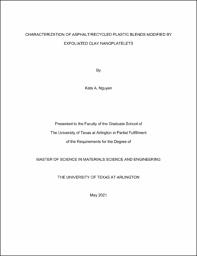
ATTENTION: The works hosted here are being migrated to a new repository that will consolidate resources, improve discoverability, and better show UTA's research impact on the global community. We will update authors as the migration progresses. Please see MavMatrix for more information.
Show simple item record
| dc.contributor.advisor | Konsta-Gdoutos, Maria S | |
| dc.creator | Nguyen, Kate A. | |
| dc.date.accessioned | 2021-06-01T20:35:41Z | |
| dc.date.available | 2021-06-01T20:35:41Z | |
| dc.date.created | 2021-05 | |
| dc.date.issued | 2021-05-09 | |
| dc.date.submitted | May 2021 | |
| dc.identifier.uri | http://hdl.handle.net/10106/29810 | |
| dc.description.abstract | There is a renewed interest from federal and state transportation agencies as well as the asphalt industry in developing successful utilization of recycled plastics in asphalt pavements. By incorporating a third material into the asphalt/plastic blend, a stimulation of enhanced compatibility between the waste plastics and asphalt can be observed. In this thesis, the need for increased stability and improved mechanical performance of asphalt blends, at low and high temperatures, are addressed through the use of dispersed/exfoliated organic montmorillonite nanoplatelets a.k.a. nanoclay (NC). Previous studies with non-dispersed NC as a modifier in asphalt (AS) and polyethylene (PE) blends reported the addition of NC may have the potential to modify the natural viscoelastic behavior, thus affecting the thermal stability.
This project aims to introduce an innovative technology for the production of a novel asphalt blend that is an environmentally friendly, viable, and more economical alternative for pavement construction. The stability and enhanced cracking/rutting resistance at cold and hot temperatures of the product will contribute to improving the safety and serviceability of roadways while reducing the maintenance/repair costs.
Fourier-transform infrared (FTIR) spectroscopy analyses conducted showed evidence of new chemical interactions between the dispersed nanoparticles and asphalt/plastic blend, suggesting a better-blended phase morphology. The indirect tensile (IDT) strength test was performed on AS/PE blends with and without reinforced NC, both dispersed and non-dispersed. The results showed an increase in tensile strength and the stress-strain ratio of the proposed material that indicates a higher modulus of elasticity. Scanning electron microscopy (SEM) was also used to examine the fracture surface of the AS/PE/NC-d sample to identify the presence of NC. | |
| dc.format.mimetype | application/pdf | |
| dc.language.iso | en_US | |
| dc.subject | Asphalt | |
| dc.subject | Recycled plastics | |
| dc.subject | Nanoclay | |
| dc.subject | Nanomodification | |
| dc.subject | Fourier transform infrared spectroscopy | |
| dc.subject | Indirect tensile strength | |
| dc.title | CHARACTERIZATION OF ASPHALT/RECYCLED PLASTIC BLENDS MODIFIED BY EXFOLIATED CLAY NANOPLATELETS | |
| dc.type | Thesis | |
| dc.degree.department | Materials Science and Engineering | |
| dc.degree.name | Master of Science in Materials Science and Engineering | |
| dc.date.updated | 2021-06-01T20:35:42Z | |
| thesis.degree.department | Materials Science and Engineering | |
| thesis.degree.grantor | The University of Texas at Arlington | |
| thesis.degree.level | Masters | |
| thesis.degree.name | Master of Science in Materials Science and Engineering | |
| dc.type.material | text | |
| dc.creator.orcid | 0000-0002-2829-3576 | |
Files in this item
- Name:
- NGUYEN-THESIS-2021.pdf
- Size:
- 2.527Mb
- Format:
- PDF
This item appears in the following Collection(s)
Show simple item record


